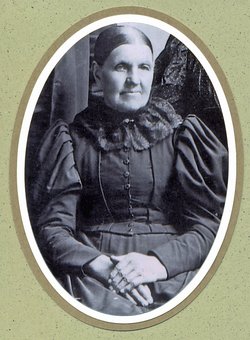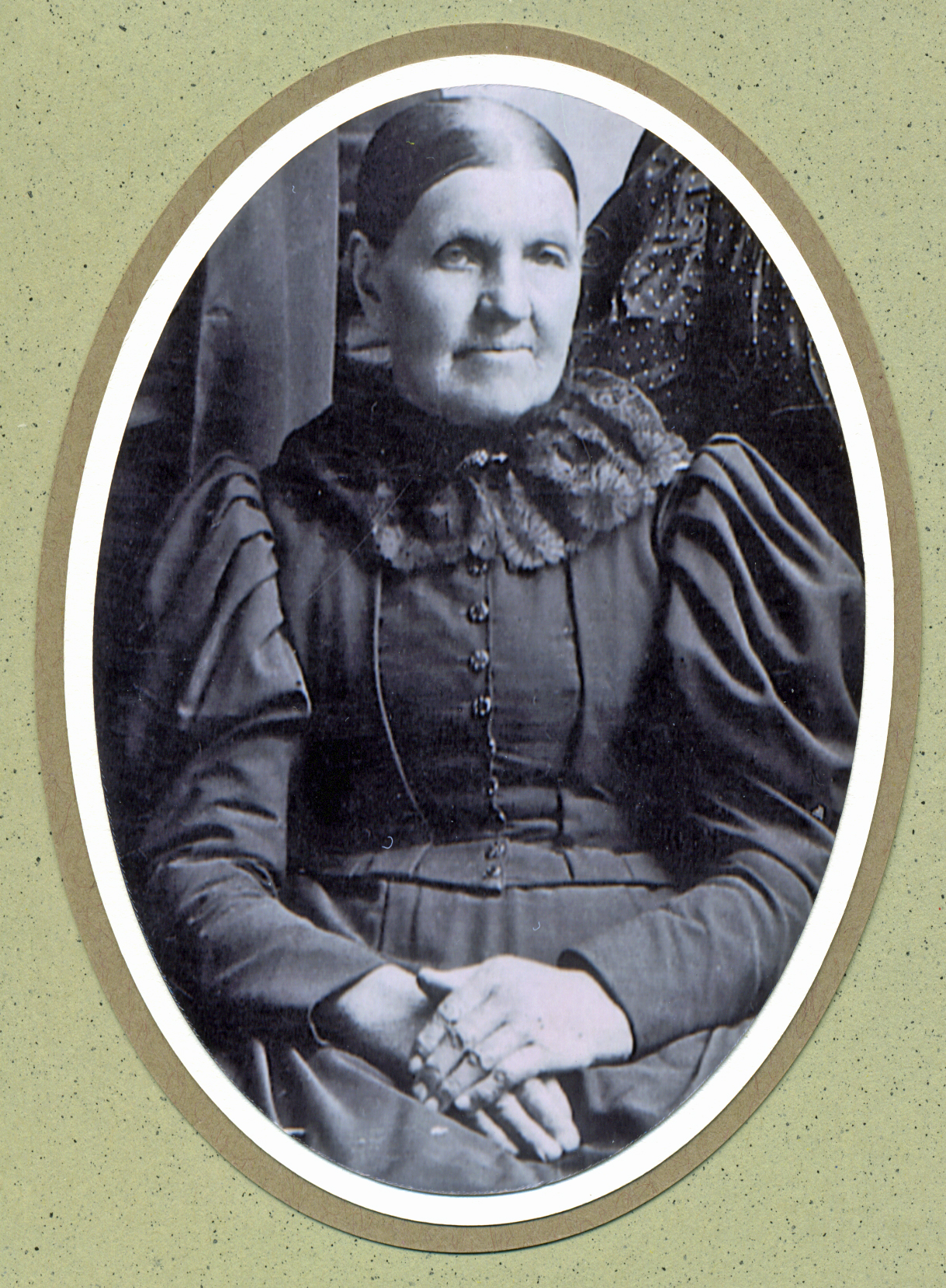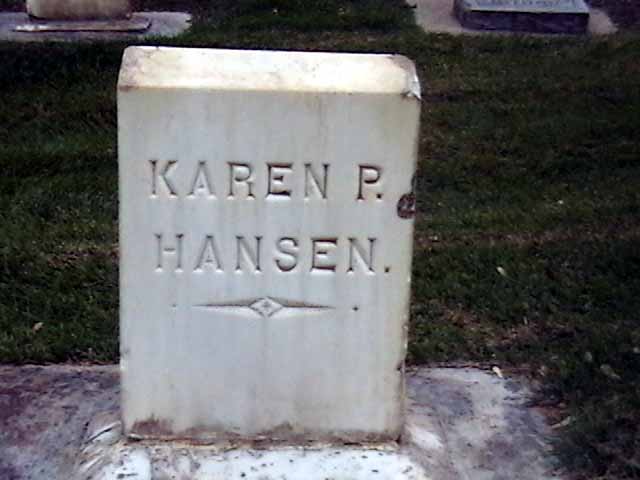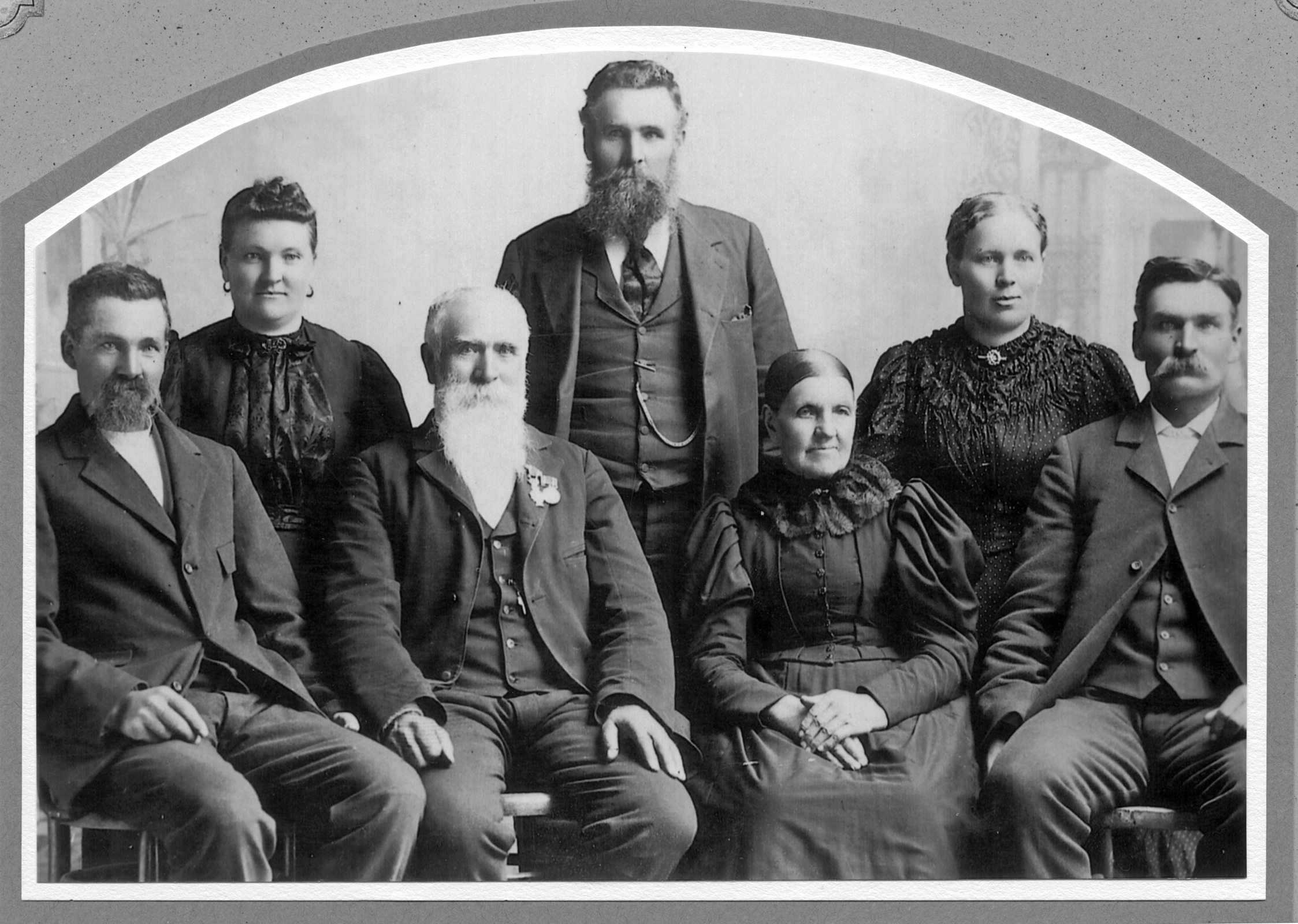Written by Sarah P. Hansen Swenson, daughter of Karen Pedersdatter Hansen of the Daughters of Utah Pioneers of Utah Company, Camp Jens Hansen, Spanish Fork, Utah.
Edited by Kitty Bryan Johnson
Karen Pedersdatter, youngest daughter of Peder and Maren Johansdatter Pedersen, was born in Ackerup (Akkerup), Funen, Denmark, February 2, 1825.
She had little chance for much education as she had to work as a hired girl as early as possible to assist the family.
She married Peder Hansen April 24, 1851. Two girls were born from this union.
Karen was baptized a member of the Church of Jesus Christ of Latter-day Saints on March 9, 1853. With her husband and little daughter Ane Dorthea Christina she left her native country that same year on December 26 to join with the Mormon people in America.
Two brothers of her husband, James and Jorgen Hansen, and a large company of saints arrived in Liverpool, England on January 9, 1854. Here on the 16th day of January she gave birth to a baby girl. Her sister-in-law, Mrs. James Hansen, gave birth to a baby boy that same day.
When the babies were three days old, they started the journey across the ocean on the said ship, Benjamin Adams. Both the women were very sick on the journey. While on the ship, measles broke out and little Ane Dorthea Christina took sick and died. She was buried in the Atlantic Ocean.
They were on the ocean seven weeks and then landed at New Orleans.
After they arrived at Kansas City, cholera broke out in their camp, and Jorgen Hansen and several of his children died. Immediately after that, they commenced their journey with ox teams and wagons across the plains.
They had only traveled a few days when Karen’s husband, Peder, became ill and died. He was buried on the plains.
Shortly after that, her sister-in-law, Mrs. James (Jens) Hansen was taken ill and died on July 29.
Karen was sick all the way, and while on the plains. Her little baby Ane Dorthea, also died and was buried between two large trees. They left enough room for another grave thinking Karen would die and be buried by the side of her child. But she revived and her life was spared to complete the journey to Utah.
She was comforted to some extent by taking and nursing her little nephew Joseph Hansen, the son of Jens and Maren Hansen, who was born the same day as her own baby. Maren had died on July 29.
They finally arrived in Salt Lake City, October 9, 1854, almost a year from the time they left Denmark.
On February 3, 1855, Karen was married to James (Jens) Hansen, brother of her first husband, Peder Hansen, who had lost his wife and child during the hard journey. She continued to care for his baby Joseph, whom she had cared for since his mother’s death. They endured the hardships of pioneer life together.
When her son Peter Hansen was born April 28, 1856, there was but five pounds of bran to be had. This was saved for mother while she was sick. The rest of the family must live on roots until harvest time.
They were blessed with some grain at harvest time, for which they were thankful to their Heavenly Father.
On July 24, 1857 word was received that Johnson’s army was headed for Utah. Preparations were started for protection against the army. All the women and children were to leave Salt Lake City, while the men stayed in the city on guard prepared to set fire to their homes in, case the army tried to take possession of their city.
The Hansen family lived in Salt Lake City until July 1, 1858. They then moved to Spanish Fork, where her daughter Mary was born a few days after they arrived there.
She was president of the teachers of the Relief Society for several years before the wards were divided. She called the teachers together once a month and visited among all the Relief Society workers of the city; thus she became acquainted with almost everyone in Spanish Fork. When the city was divided into wards, she was chosen President of the Fourth Ward Relief Society, which position she held until she passed away.
She was very desirous of having a Relief Society house and worked hard to get the Relief Society Hall we are still using.
Her husband, James Hansen, gave the ground and she had the sisters come to their home, where they sewed carpet rags and made quilts and did all the work they could to get money to build the house. She always served refreshments to the workers.
She lived to see the house completed. The first meeting held in the Relief Society Hall was held a few days before her death. Her funeral was the second public meeting to be held in the house she had labored so hard to help build.
In the home she was looked to as the manager and her advice was sought by the rest of the family.
In the home each wife had her certain work to do. Mother had the duty of cooking for the whole family. She always had to bake bread twice each day. There was usually a large family to cook for. At one time there were thirty-five in the family.
She was head of the family quite a share of the time, as her husband was sent on three different missions to Denmark.
When he received the call for his first mission in 1866, he was at work in the fields at Palmyra. The day the call came she walked out to the fields to take the letter to him. He had to be ready to leave in a few days. He left his four wives and seventeen children, the oldest twelve years old, and went back to his native land for two and one-half years.
Times were not very prosperous then. Whenever a nickle could be had, it was saved to buy a stamp to send a letter to Father.
On his return from his first mission, Father was surprised to find that his wives and children had gleaned over 300 bushels of wheat. The oldest boys, not yet in their teens, had planted and harvested some also.
Mother made the tallow candles for our only light. We had a few sheep which we sheared; the wool we corded and spun and wove into cloth for dresses and suits for the boys.
Conditions were quite different in those days than now.
There were no stores to buy our supplies from; we had to raise our own food and make our own clothing. We raised our vegetables and cured our meats. We raised sugar cane and made our own molasses. We preserved some fruit with the molasses and dried fruit and ground cherries.
After the manifesto the family couldn't live together, so each wife had her own home or apartment, and Mother had her own little home where she lived with Father and her brother-in-law, George Peter Hansen, who had always made his home with them. Brother Benjamin Hansen, whose mother had died several years before, also lived with them. Her home was always open to poor people and many of the emigrants from Denmark were quite often entertained there, sometimes for weeks, until they could get settled some place.
For several years before her death, it was customary to have all her grandchildren come a certain day during the holidays and she would bake “evelskew”, a Danish fried cake. Several of them still remember that day.
She died May 12, 1896. She lived and died a faithful Latter-day Saint. Her posterity now numbers several hundred. She was mother of eight children as follows: Ane Dorthea Christena, Ane Krestine Hansen, Peter P. Hansen, Maren Krestine Hansen Beckstrom, Sarah P. Hansen Swenson, Isaac P. Hansen, Emma Dorthea Hansen, Hyrum P. Hansen, also her foster son Joseph Hansen.
Written by Sarah P. Hansen Swenson, daughter of Karen Pedersdatter Hansen of the Daughters of Utah Pioneers of Utah Company, Camp Jens Hansen, Spanish Fork, Utah.
Edited by Kitty Bryan Johnson
Karen Pedersdatter, youngest daughter of Peder and Maren Johansdatter Pedersen, was born in Ackerup (Akkerup), Funen, Denmark, February 2, 1825.
She had little chance for much education as she had to work as a hired girl as early as possible to assist the family.
She married Peder Hansen April 24, 1851. Two girls were born from this union.
Karen was baptized a member of the Church of Jesus Christ of Latter-day Saints on March 9, 1853. With her husband and little daughter Ane Dorthea Christina she left her native country that same year on December 26 to join with the Mormon people in America.
Two brothers of her husband, James and Jorgen Hansen, and a large company of saints arrived in Liverpool, England on January 9, 1854. Here on the 16th day of January she gave birth to a baby girl. Her sister-in-law, Mrs. James Hansen, gave birth to a baby boy that same day.
When the babies were three days old, they started the journey across the ocean on the said ship, Benjamin Adams. Both the women were very sick on the journey. While on the ship, measles broke out and little Ane Dorthea Christina took sick and died. She was buried in the Atlantic Ocean.
They were on the ocean seven weeks and then landed at New Orleans.
After they arrived at Kansas City, cholera broke out in their camp, and Jorgen Hansen and several of his children died. Immediately after that, they commenced their journey with ox teams and wagons across the plains.
They had only traveled a few days when Karen’s husband, Peder, became ill and died. He was buried on the plains.
Shortly after that, her sister-in-law, Mrs. James (Jens) Hansen was taken ill and died on July 29.
Karen was sick all the way, and while on the plains. Her little baby Ane Dorthea, also died and was buried between two large trees. They left enough room for another grave thinking Karen would die and be buried by the side of her child. But she revived and her life was spared to complete the journey to Utah.
She was comforted to some extent by taking and nursing her little nephew Joseph Hansen, the son of Jens and Maren Hansen, who was born the same day as her own baby. Maren had died on July 29.
They finally arrived in Salt Lake City, October 9, 1854, almost a year from the time they left Denmark.
On February 3, 1855, Karen was married to James (Jens) Hansen, brother of her first husband, Peder Hansen, who had lost his wife and child during the hard journey. She continued to care for his baby Joseph, whom she had cared for since his mother’s death. They endured the hardships of pioneer life together.
When her son Peter Hansen was born April 28, 1856, there was but five pounds of bran to be had. This was saved for mother while she was sick. The rest of the family must live on roots until harvest time.
They were blessed with some grain at harvest time, for which they were thankful to their Heavenly Father.
On July 24, 1857 word was received that Johnson’s army was headed for Utah. Preparations were started for protection against the army. All the women and children were to leave Salt Lake City, while the men stayed in the city on guard prepared to set fire to their homes in, case the army tried to take possession of their city.
The Hansen family lived in Salt Lake City until July 1, 1858. They then moved to Spanish Fork, where her daughter Mary was born a few days after they arrived there.
She was president of the teachers of the Relief Society for several years before the wards were divided. She called the teachers together once a month and visited among all the Relief Society workers of the city; thus she became acquainted with almost everyone in Spanish Fork. When the city was divided into wards, she was chosen President of the Fourth Ward Relief Society, which position she held until she passed away.
She was very desirous of having a Relief Society house and worked hard to get the Relief Society Hall we are still using.
Her husband, James Hansen, gave the ground and she had the sisters come to their home, where they sewed carpet rags and made quilts and did all the work they could to get money to build the house. She always served refreshments to the workers.
She lived to see the house completed. The first meeting held in the Relief Society Hall was held a few days before her death. Her funeral was the second public meeting to be held in the house she had labored so hard to help build.
In the home she was looked to as the manager and her advice was sought by the rest of the family.
In the home each wife had her certain work to do. Mother had the duty of cooking for the whole family. She always had to bake bread twice each day. There was usually a large family to cook for. At one time there were thirty-five in the family.
She was head of the family quite a share of the time, as her husband was sent on three different missions to Denmark.
When he received the call for his first mission in 1866, he was at work in the fields at Palmyra. The day the call came she walked out to the fields to take the letter to him. He had to be ready to leave in a few days. He left his four wives and seventeen children, the oldest twelve years old, and went back to his native land for two and one-half years.
Times were not very prosperous then. Whenever a nickle could be had, it was saved to buy a stamp to send a letter to Father.
On his return from his first mission, Father was surprised to find that his wives and children had gleaned over 300 bushels of wheat. The oldest boys, not yet in their teens, had planted and harvested some also.
Mother made the tallow candles for our only light. We had a few sheep which we sheared; the wool we corded and spun and wove into cloth for dresses and suits for the boys.
Conditions were quite different in those days than now.
There were no stores to buy our supplies from; we had to raise our own food and make our own clothing. We raised our vegetables and cured our meats. We raised sugar cane and made our own molasses. We preserved some fruit with the molasses and dried fruit and ground cherries.
After the manifesto the family couldn't live together, so each wife had her own home or apartment, and Mother had her own little home where she lived with Father and her brother-in-law, George Peter Hansen, who had always made his home with them. Brother Benjamin Hansen, whose mother had died several years before, also lived with them. Her home was always open to poor people and many of the emigrants from Denmark were quite often entertained there, sometimes for weeks, until they could get settled some place.
For several years before her death, it was customary to have all her grandchildren come a certain day during the holidays and she would bake “evelskew”, a Danish fried cake. Several of them still remember that day.
She died May 12, 1896. She lived and died a faithful Latter-day Saint. Her posterity now numbers several hundred. She was mother of eight children as follows: Ane Dorthea Christena, Ane Krestine Hansen, Peter P. Hansen, Maren Krestine Hansen Beckstrom, Sarah P. Hansen Swenson, Isaac P. Hansen, Emma Dorthea Hansen, Hyrum P. Hansen, also her foster son Joseph Hansen.
Family Members
Advertisement
See more Hansen or Pedersdatter memorials in:
- Spanish Fork City Cemetery Hansen or Pedersdatter
- Spanish Fork Hansen or Pedersdatter
- Utah County Hansen or Pedersdatter
- Utah Hansen or Pedersdatter
- USA Hansen or Pedersdatter
- Find a Grave Hansen or Pedersdatter
Records on Ancestry
Advertisement












